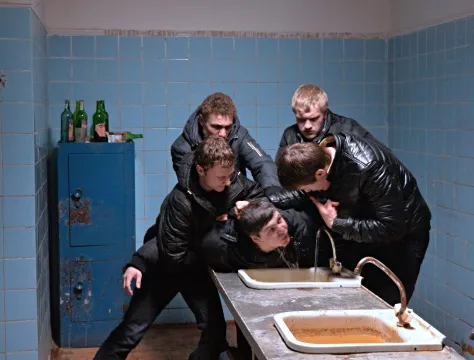
The Tribe is the first work of director Myroslav Slaboshpitsky, known for his short films, which premiered at the Cannes Critics' Week in 2014, and whose most striking feature is the fact that this film is made entirely in sign language (Ukrainian) by non-professional deaf and mute actors and has neither translation nor subtitles.
It is also, as its title indicates, a film that presents us, through Sergey, who enters an education center for deaf-mute children and young people, a clandestine network of smuggling and pimping that its students form with the help of one of their teachers, which is articulated as a closed system of its own codes and rules, a small parallel and marginal society with strict hierarchies and rituals in which the radical absence of values reigns.
I confess that at the beginning I had my doubts about this film: a film without dialogue, silent actors, will it be possible to understand it without subtitles or words? Shortly after turning the tables and the director shows us the question of the deaf and dumb as a marginalized world in reverse, so that in the film it is the viewer who does not have the tools to understand what they say to each other: he seeks to extreme the incomprehension by presenting the "experience" of these people unable to utter words but with excessive realism.
As the film develops, the story ends up falling from the middle of the film into several common places, where the viewer is no longer alienated by his incomprehension of the language between the characters, but you can easily and comfortably resort to your own filmic intelligence to understand and follow the story, without even having to make the attempt to understand what the characters are saying to each other. This is part of the effect of the director's decision not to translate or subtitle the Ukrainian sign language, which while an interesting decision, necessarily forces us to take refuge in the explicit.
It seems to me that even though we cannot "read" what the characters say and therefore we do not have access to their interiority or feelings, my feeling is that none of them, except the protagonist, has any kind of evolution within the film, which is not a problem if what happens in the story were not an accumulation of common places, where the provocative and harsh use of bloody scenes one after another will end up anesthetizing in some way the film's proposal, attacking itself more than the viewer. For the shocking use of violence in several scenes, including the game (otherwise repeated) of using the characters' deafness versus our ability to hear what is happening in the shot to hurt one of the characters, turns out to be more sordid than propositive. We don't understand what they say to each other, but everything is shown, everything is exposed, everything is over-understood.
In this sense, it seems to me that the most remarkable and enjoyable feature of the film is the talking choreography, where sign language positions us in front of this incessant movement of arms and hands interspersed with short sounds, ruminations, moans, groans, blows, touch, a constant agitation, in a context of constantly boiling violence, at the surface of the skin, at the tip of the hands.
The loquacity of these hyperactive gestures, like a centrifugal attentional surplus used in a choreographic way of an overflowing energy that is managed within the frame, presented in a much more restrained way than in the director's previous short film with deaf-mutes (Deafness, 2010), where the deaf-mute characters ended up painfully and almost parodically imitating verbal communication, where deafness was treated as a disability, a distance from the world and from understanding, is used in The Tribe in a purposeful way where the acting gesture of these non-professional deaf-mutes is impeccable in the film and is perhaps the greatest achievement of the film.
In this way, the interesting thing is in the acting and direction of actors that builds during the 130 minutes of the film, hand in hand with a sound conception that manages to keep our attention in the tension between sound and non-sound, in addition to the use of the camera with long sequence shots that allow the gravitational center of the film to be the group dynamics and the movement of the bodies in the frame, where the spatial detachment of the physical proposes more than the hypervisibility of shock, of that shocking and surprising effect in which the story falls again and again. It is perhaps the problem of making a fiction with realistic pretensions, which seeks to link the violence of a minority with their marginality/disability.

